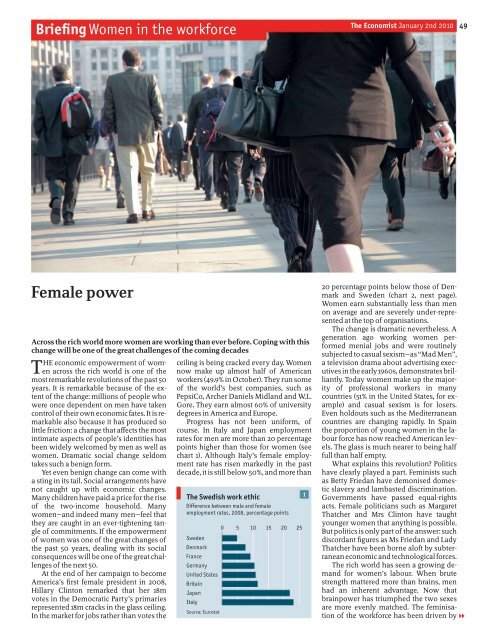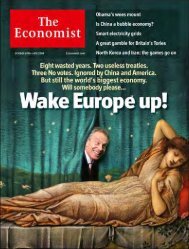Economics focus - the ultimate blog
Economics focus - the ultimate blog
Economics focus - the ultimate blog
Create successful ePaper yourself
Turn your PDF publications into a flip-book with our unique Google optimized e-Paper software.
Brieng Women in <strong>the</strong> workforce<br />
Female power<br />
Across <strong>the</strong> rich world more women are working than ever before. Coping with this<br />
change will be one of <strong>the</strong> great challenges of <strong>the</strong> coming decades<br />
THE economic empowerment of women<br />
across <strong>the</strong> rich world is one of <strong>the</strong><br />
most remarkable revolutions of <strong>the</strong> past 50<br />
years. It is remarkable because of <strong>the</strong> extent<br />
of <strong>the</strong> change: millions of people who<br />
were once dependent on men have taken<br />
control of <strong>the</strong>ir own economic fates. It is remarkable<br />
also because it has produced so<br />
little friction: a change that aects <strong>the</strong> most<br />
intimate aspects of people’s identities has<br />
been widely welcomed by men as well as<br />
women. Dramatic social change seldom<br />
takes such a benign form.<br />
Yet even benign change can come with<br />
a sting in its tail. Social arrangements have<br />
not caught up with economic changes.<br />
Many children have paid a price for <strong>the</strong> rise<br />
of <strong>the</strong> two-income household. Many<br />
womenand indeed many menfeel that<br />
<strong>the</strong>y are caught in an ever-tightening tangle<br />
of commitments. If <strong>the</strong> empowerment<br />
of women was one of <strong>the</strong> great changes of<br />
<strong>the</strong> past 50 years, dealing with its social<br />
consequences will be one of <strong>the</strong> great challenges<br />
of <strong>the</strong> next 50.<br />
At <strong>the</strong> end of her campaign to become<br />
America’s rst female president in 2008,<br />
Hillary Clinton remarked that her 18m<br />
votes in <strong>the</strong> Democratic Party’s primaries<br />
represented 18m cracks in <strong>the</strong> glass ceiling.<br />
In <strong>the</strong> market for jobs ra<strong>the</strong>r than votes <strong>the</strong><br />
ceiling is being cracked every day. Women<br />
now make up almost half of American<br />
workers (49.9% in October). They run some<br />
of <strong>the</strong> world’s best companies, such as<br />
PepsiCo, Archer Daniels Midland and W.L.<br />
Gore. They earn almost 60% of university<br />
degrees in America and Europe.<br />
Progress has not been uniform, of<br />
course. In Italy and Japan employment<br />
rates for men are more than 20 percentage<br />
points higher than those for women (see<br />
chart 1). Although Italy’s female employment<br />
rate has risen markedly in <strong>the</strong> past<br />
decade, it is still below 50%, and more than<br />
The Swedish work ethic<br />
Difference between male and female<br />
employment rates, 2008, percentage points<br />
Sweden<br />
Denmark<br />
France<br />
Germany<br />
United States<br />
Britain<br />
Japan<br />
Italy<br />
Source: Eurostat<br />
0 5 10 15 20 25<br />
1<br />
The Economist January 2nd 2010 49<br />
20 percentage points below those of Denmark<br />
and Sweden (chart 2, next page).<br />
Women earn substantially less than men<br />
on average and are severely under-represented<br />
at <strong>the</strong> top of organisations.<br />
The change is dramatic never<strong>the</strong>less. A<br />
generation ago working women performed<br />
menial jobs and were routinely<br />
subjected to casual sexismas Mad Men,<br />
a television drama about advertising executives<br />
in <strong>the</strong> early 1960s, demonstrates brilliantly.<br />
Today women make up <strong>the</strong> majority<br />
of professional workers in many<br />
countries (51% in <strong>the</strong> United States, for example)<br />
and casual sexism is for losers.<br />
Even holdouts such as <strong>the</strong> Mediterranean<br />
countries are changing rapidly. In Spain<br />
<strong>the</strong> proportion of young women in <strong>the</strong> labour<br />
force has now reached American levels.<br />
The glass is much nearer to being half<br />
full than half empty.<br />
What explains this revolution? Politics<br />
have clearly played a part. Feminists such<br />
as Betty Friedan have demonised domestic<br />
slavery and lambasted discrimination.<br />
Governments have passed equal-rights<br />
acts. Female politicians such as Margaret<br />
Thatcher and Mrs Clinton have taught<br />
younger women that anything is possible.<br />
But politics is only part of <strong>the</strong> answer: such<br />
discordant gures as Ms Friedan and Lady<br />
Thatcher have been borne aloft by subterranean<br />
economic and technological forces.<br />
The rich world has seen a growing demand<br />
for women’s labour. When brute<br />
strength mattered more than brains, men<br />
had an inherent advantage. Now that<br />
brainpower has triumphed <strong>the</strong> two sexes<br />
are more evenly matched. The feminisation<br />
of <strong>the</strong> workforce has been driven by 1








![[ccebbook.cn]The Economist August 1st 2009 - the ultimate blog](https://img.yumpu.com/28183607/1/190x252/ccebbookcnthe-economist-august-1st-2009-the-ultimate-blog.jpg?quality=85)



![[ccebook.cn]The World in 2010](https://img.yumpu.com/12057568/1/190x249/ccebookcnthe-world-in-2010.jpg?quality=85)
![[ccemagz.com]The Economist October 24th 2009 - the ultimate blog](https://img.yumpu.com/5191885/1/190x252/ccemagzcomthe-economist-october-24th-2009-the-ultimate-blog.jpg?quality=85)